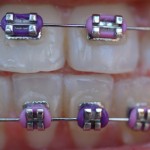
The provision of fixed appliance orthodontic treatment is routine for a large proportion of adolescents and enamel white spot lesions are a common adverse event associated with treatment being seen in up to 70% of patients according to some studies.
The aim of this review was to assess the evidence for professional topical fluoride application in the prevention and reversal of enamel white spot lesions during or after fixed appliance orthodontic treatment.
Methods
Searches were conducted in the Medline, Embase, Cochrane Library and Scopus databases. Randomised controlled trials (RCTs) or quasi-RCTs involving professional topical fluoride applications for patients undergoing fixed appliance orthodontic treatment for the prevention of enamel white spot lesions (WSLs) were considered. Two reviewers independently selected studies and abstracted data with risk of bias being assessed using the Cochrane tool. Quantitative synthesis was carried out when two or more studies addressed the same outcome.
Results
- 11 studies reported in 12 papers were included, 4 studies assessed prevention of WSLs and 7 reversals.
- 5 studies were considered to be at low risk of bias, 4 at some risk and 2 at high risk of bias.
- Prevention
- 4 studies involved 518 patients.
- 3 studies contributed to a meta-analysis finding that professional topical fluoride agents can decrease the risk of EWSLs in patients undergoing multi-bracketed fixed orthodontic treatment by 41–74%. RR= 0.39 (95%CI; 0.26 to 0.59).
- Reversals
- 7 studies involved 693 patients.
- 3 studies contributed to a meta-analysis. The standardised mean difference (SMD) for DIAGNOdent scores was lower in the professional topical fluoride group than the control group SMD= 0.57 (95%CI; 0.23 to -0.91).
Conclusions
The authors concluded: –
professional topical fluoride application brought about a 25–30% reduction in the incidence of WSLs after debonding; however, the effect of professional topical fluoride application in a reversal of WSLs was unclear due to the concerns in interpreting DIAGNOdent values to estimate WSLs.
Comments
A number of previous reviews have looked at the problem of WSLs related to fixed appliance orthodontic treatment. (Dental Elf – Apr 16th 2016, Dental Elf – 27th Jan 2014). Those earlier reviews both suggest a benefit in prevention of WSLs from topical fluoride applications although they include fewer trials owing to some more recent publications. So, while the newer trials improve the amount of evidence available to support the use of topical fluorides to prevent WSLs just under 50% are of low risk of bias so more high quality well reported studies are needed to clarify the evidence in relation to both prevention and reversal of WSLs during and following fixed appliance orthodontic treatment. In particular in relation to the application frequencies, type, concentrations of fluoride and different follow-ups periods.
Links
Primary Paper
Sardana D, Zhang J, Ekambaram M, Yang Y, McGrath CP, Yiu CKY. Effectiveness of professional fluorides against enamel white spot lesions during fixed orthodontic treatment: A systematic review and meta-analysis. J Dent. 2018 Dec 21. pii:S0300-5712(18)30553-0. doi: 10.1016/j.jdent.2018.12.006. [Epub ahead of print]Review. PubMed PMID: 30579859.
Other references
Dental Elf – Apr 16th 2016
Post-orthodontic white spot lesions – lack of reliable evidence for management strategies
Dental Elf – 27th Jan 2014

[…] Fluoride for white spot lesion prevention during orthodontic treatment […]